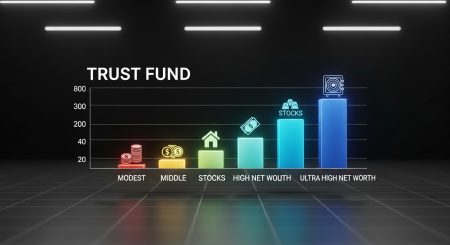Trust funds are not just for old money. They can secure family wealth, protect a growing company, or fund a child’s future. If you run a small business or a startup, a trust can be a smart planning tool.
A trust fund is a legal arrangement that holds assets for someone else’s benefit. You can set rules, timing, and control over how money is managed and paid out.
Knowing the average trust fund amount helps you plan what’s realistic for inheritance, exits, or business funding.
Here is the quick answer you came for. The median trust fund amount is about $285,000. That figure is a middle point, so actual amounts vary a lot.
What drives the spread? Type and age. Revocable living trusts used for estate planning often sit in the mid-six figures, while business or investment trusts can be much larger.
Younger beneficiaries tend to see smaller balances, and values rise with age and wealth.
Picture this. A founder puts a portion of company shares into a trust with voting guidelines and a payout schedule.
If something happens to them, the trustee follows the plan, keeps payroll going, and funds a smooth succession without a rushed sale.
You will see how different trust types compare, where that $285,000 fits, and what that means for cash flow, taxes, and control.
By the end, you will know how to align the average trust fund amount with your goals, whether that is protecting family assets or backing your next stage of growth.
Explore our latest article on What Does a Trust Fund Do? A Simple Guide for Founders to multiply your experience.
What Is the Average Trust Fund Amount?

The average trust fund amount depends on who holds it and for how long it has been growing. Time, contributions, and market returns do most of the heavy lifting.
If you are planning for family or your company’s future, the pattern by age is a helpful benchmark.
Use this section to fame your own plan, not to copy someone else’s numbers. Your mix of assets, taxes, and goals will drive the right amount for you.
Average Trust Fund Amounts by Beneficiary Age
Trust balances usually rise with age, since older beneficiaries have had more time for compounding and contributions. Here is a simple snapshot.
-
Young adults (under 35): $180,000
-
Ages 35 to 44: $570,000
-
Ages 45 to 54: $1,000,000
-
Ages 55 to 64: $1,700,000
-
Seniors (65 to 74): $2,400,000
-
Elderly (75+): $2,600,000
Why do these amounts grow over time?
-
Compound returns: Earnings sit inside the trust, get reinvested, and snowball.
-
Added contributions: Parents, grandparents, or the business add assets during high-earning years.
-
Asset mix shift: Portfolios tilt from growth to income as balances rise, which can boost stability.
-
Tax planning: Trust structures can reduce friction from taxes, keeping more capital working.
If you run a small business, start early to reach or beat the average trust fund amount for your goals.
-
Set a target: Tie the trust to a clear purpose, like college funding, a buy-sell, or key person risk.
-
Fund on a schedule: Automate contributions from profits, even if they are small at first.
-
Use growth assets: Include index funds or business equity for long-term compounding.
-
Add rules: Define payouts, trustee powers, and voting control to protect the business.
A quick example: you set aside $1,000 per month into a trust invested in a balanced portfolio.
Over a decade, steady deposits plus market returns can push you closer to the mid-six-figure range, even before any windfall or exit. Start now, and let time do the heavy lifting.
Key Factors That Shape Trust Fund Amounts

The average trust fund amount is influenced by a handful of moving parts you can actually plan around. Your mix of assets, the rate environment, and how long the money compounds all matter.
Get those right, and your trust can track above the median, even with modest contributions.
Think of a trust like a portfolio with rules. The rules guide payouts and control, the portfolio drives growth. interest rates, stock market momentum, and inflation sit at the center of that growth story.
How Economic Trends Affect Your Trust
Rates remain moderately high, with the market expecting only a few cuts by year-end. That keeps cash and high-quality bonds yielding near 4% in many cases.
Stocks show slower, bumpier growth, yet productivity gains, especially in tech, still support long-term returns.
What does that mean for the average trust fund amount? Balanced portfolios tend to hold up best. Trusts that stay all-in on cash may lag, while aggressive equity-heavy trusts ride volatility to chase higher upside.
Here is a quick view of how common 2025 scenarios can impact trust values:
| 2025 Scenario | What’s Likely | Impact on Trusts | Who Benefits |
|---|---|---|---|
| Rates steady near 4% | Limited cuts, sticky inflation | Bonds and cash pay decent income, less rally in long bonds | Income-focused or short-duration bond holders |
| Choppy equities | Earnings growth with volatility | Higher long-run upside, short-term swings | Equity-weighted trusts with a 5 to 10-year view |
| Productivity uptick | Tech-led efficiency | Quality growth stocks lead | Diversified index and tech tilts |
| Slowing global growth | Mixed regional outlook | Defensive sectors and value matter | Balanced portfolios with dividends |
Pros and cons by economic setup help you tune the mix:
Rising or steady rates near 4%
-
Pros: Better income from Treasuries, CDs, and short bond ladders.
-
Cons: Long-term bonds can lose value if rates bounce.
Choppy stock market with moderate gains
-
Pros: Dollar-cost averaging shines, quality companies compound.
-
Cons: Big swings can force bad sales if payouts are frequent.
Cooling inflation
-
Pros: Improves real returns, supports consumer demand.
-
Cons: If growth slows too, earnings may compress.
Asset choices create real variation inside trusts. A conservative trust with short bonds and cash may produce 3% to 5% annually.
A balanced 60/40 mix might target 5% to 7% over a full cycle. An equity-tilted trust can reach higher, though you must stomach volatility and fund payouts from cash buffers.
Simple, low-cost moves for startup founders who want to protect assets in trusts:
-
Use a revocable living trust: Avoid probate and keep control while you are alive. Cheap to set up, strong for continuity.
-
Title key assets correctly: Brokerage accounts or a portion of company shares should flow under the trust terms.
-
Keep 6 to 12 months of distributions in cash or Treasuries: This reduces forced selling during selloffs.
-
Favor low-fee index funds: Use for core exposure. Add sector ETFs or a single high-conviction fund if needed.
-
Automate quarterly contributions: Even small deposits compound into serious money over time.
-
Add basic guardrails: Distribution schedules, trustee powers, and voting guidelines protect control during a health event or exit.
Key takeaway: Balance is your friend. Structure the portfolio so income covers near-term needs, then let equities power long-term growth.
That mix gives your trust a clear path to sustain or outpace the average trust fund amount.
Why Small Business Owners Should Consider Trust Funds

If you own a business, a trust is a planning tool that keeps money, equity, and family interests organized. It gives you control while protecting assets from chaos during transitions or emergencies.
Tie your goals to the average trust fund amount so you have a clear target and timeline. See our article on Pet Trust Fund for Entrepreneurs (Setup, Costs, Benefits), for pet owners.
Protect Cash Flow, Ownership, and Family
A trust creates rules that survive you, which keeps the company steady when life gets messy. That means payroll continues, distributions follow the plan, and voting rights are handled.
-
Continuity: A trustee follows your operating playbook and avoids rushed sales.
-
Guardrails: Set payout schedules, performance milestones, and veto rights for key decisions.
-
Privacy: Avoid probate, keep terms out of public records, and reduce disputes.
Example: you place 20% of company shares in a trust with a rule to fund 6 months of payroll from dividends or a cash reserve.
Tax Efficiency That Compounds
Trusts can help manage income, capital gains, and estate tax exposure. The savings may seem small year to year, but they stack up.
-
Timing control: Shift when and how income hits a beneficiary’s return.
-
Asset location: Keep higher-yield or taxable assets in the trust, tax-efficient assets elsewhere.
-
Gifting strategy: Move growth assets early so appreciation happens outside your estate.
Why it matters: keeping 1 to 2 percentage points of return after tax can move a trust from below the average trust fund amount to above it over a decade.
Succession, Without the Fire Drill
You decide who votes shares, who manages distributions, and how a sale or buyout works. That reduces friction with partners and family.
-
Successor plan: Name backup trustees and define decision authority.
-
Buy-sell funding: Pair the trust with insurance or a staged buyout for clean exits.
-
Performance gates: Tie beneficiary access to milestones like completing training or joining the board.
This structure keeps control aligned with competence, not just inheritance.
Asset Protection and Risk Management
Trusts can shield assets from personal lawsuits, creditor claims, and messy divorces. Business owners carry more liability than most, so protection matters.
-
Segregation of assets: Keep business equity, IP, and cash buffers separate and titled correctly.
-
Discretionary payouts: Trustees can withhold distributions when a beneficiary faces claims.
-
Jurisdiction choice: Some states offer stronger protection for spendthrift provisions.
Protection is not absolute, but it raises the bar for anyone trying to reach your assets.
Funding Strategies to Reach the Average
Aim for the median $285,000, then scale as profits grow. Start small, stay steady, and let compounding help.
-
Automate quarterly transfers from profits or owner draws.
-
Use a 60/40 core (broad equity index and short-to-intermediate bonds), then add cash for 6 to 12 months of payouts.
-
Contribute windfalls, like tax refunds or bonus dividends, to accelerate growth.
Example: $1,250 per month at a 6% average return can reach the average trust fund amount in about 15 years, faster with occasional top-ups.
Trust Types That Fit Small Businesses
Pick a structure that matches your need for control, tax goals, and protection. Here is a simple guide.
-
Revocable living trust: Easiest for continuity and probate avoidance, full control while alive.
-
Irrevocable trust: Better for asset protection and estate tax planning, with less control.
-
Grantor retained annuity trust (GRAT): Move appreciating assets, like private shares, while keeping an income stream.
-
Family trust with voting rules: Hold company equity, define board roles, and set sale guidelines.
Choose the lightest solution that still covers your risks.
Costs, Timelines, and Common Mistakes
Trusts are affordable relative to the value they protect. Plan for setup, annual maintenance, and basic legal updates.
-
Typical costs: Low four figures to set up simple trusts, more for complex structures with business equity.
-
Timelines: Two to six weeks for design and funding if paperwork is ready.
Avoid these:
-
Forgetting to retitle accounts and shares into the trust.
-
No cash buffer for distributions during market dips.
-
Overly complex rules that stall normal operations.
Keep documents updated after major events like funding rounds, acquisitions, or a leadership change.
Quick Decision Framework
Use this checklist to act within 30 days and stay on track.
-
Define purpose, like succession, buy-sell funding, or education.
-
Pick a trust type and draft clear distribution and voting rules.
-
Fund with a starter mix: cash, index funds, and a defined slice of company equity.
-
Set an annual contribution goal tied to profits.
-
Review quarterly, rebalance annually, and test payouts against a downturn scenario.
Bottom line: trusts help business owners protect assets, reduce friction, and grow toward or past the average trust fund amount with fewer surprises.
Start lean, get the structure right, then let time and discipline do their work. Check out What If a Bypass Trust Is Never Funded? Risks and Fixes for broader details.
Conclusion
The headline number is clear; the median average trust fund amount sits near $285,000, yet balances vary widely by trust type and beneficiary age.
Rates, market returns, and smart rules shape outcomes, and business owners gain extra value through continuity, tax control, and cash flow planning.
Take the next step. Define your purpose, set a target, and commit to a funding schedule, then review with a qualified estate attorney and fiduciary advisor to fit your state and tax profile.
Ready to align the average trust fund amount with your goals? Thanks for reading, and share how you plan to use a trust to protect your family or business.

I am Adeyemi Adetilewa, a content marketing strategist helping B2B SaaS brands grow their organic traffic, improve search visibility, and attract qualified leads through data-driven, search-optimized content. My work is trusted by the Huffington Post, The Good Men Project, Addicted2Success, Hackernoon, and other publications.
